warning HYUNDAI I10 2017 Owner's Manual
[x] Cancel search | Manufacturer: HYUNDAI, Model Year: 2017, Model line: I10, Model: HYUNDAI I10 2017Pages: 343, PDF Size: 9.14 MB
Page 38 of 343
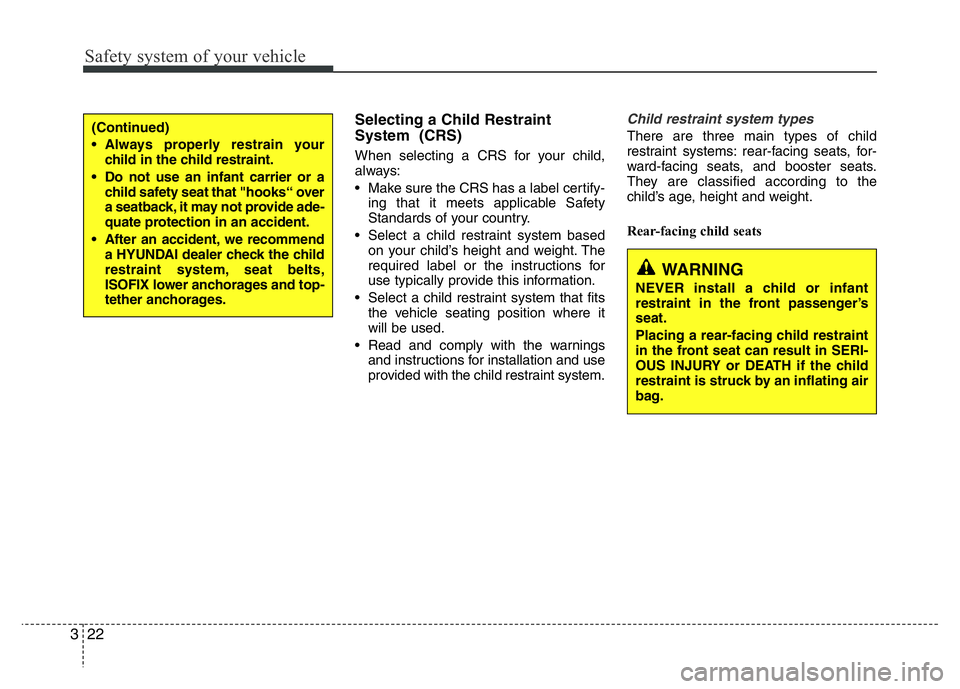
Safety system of your vehicle
22 3
Selecting a Child Restraint
System (CRS)
When selecting a CRS for your child,
always:
• Make sure the CRS has a label certify-
ing that it meets applicable Safety
Standards of your country.
• Select a child restraint system based
on your child’s height and weight. The
required label or the instructions for
use typically provide this information.
• Select a child restraint system that fits
the vehicle seating position where it
will be used.
• Read and comply with the warnings
and instructions for installation and use
provided with the child restraint system.
Child restraint system types
There are three main types of child
restraint systems: rear-facing seats, for-
ward-facing seats, and booster seats.
They are classified according to the
child’s age, height and weight.
Rear-facing child seats
WARNING
NEVER install a child or infant
restraint in the front passenger’s
seat.
Placing a rear-facing child restraint
in the front seat can result in SERI-
OUS INJURY or DEATH if the child
restraint is struck by an inflating air
bag.
(Continued)
• Always properly restrain your
child in the child restraint.
• Do not use an infant carrier or a
child safety seat that "hooks“ over
a seatback, it may not provide ade-
quate protection in an accident.
• After an accident, we recommend
a HYUNDAI dealer check the child
restraint system, seat belts,
ISOFIX lower anchorages and top-
tether anchorages.
Page 40 of 343
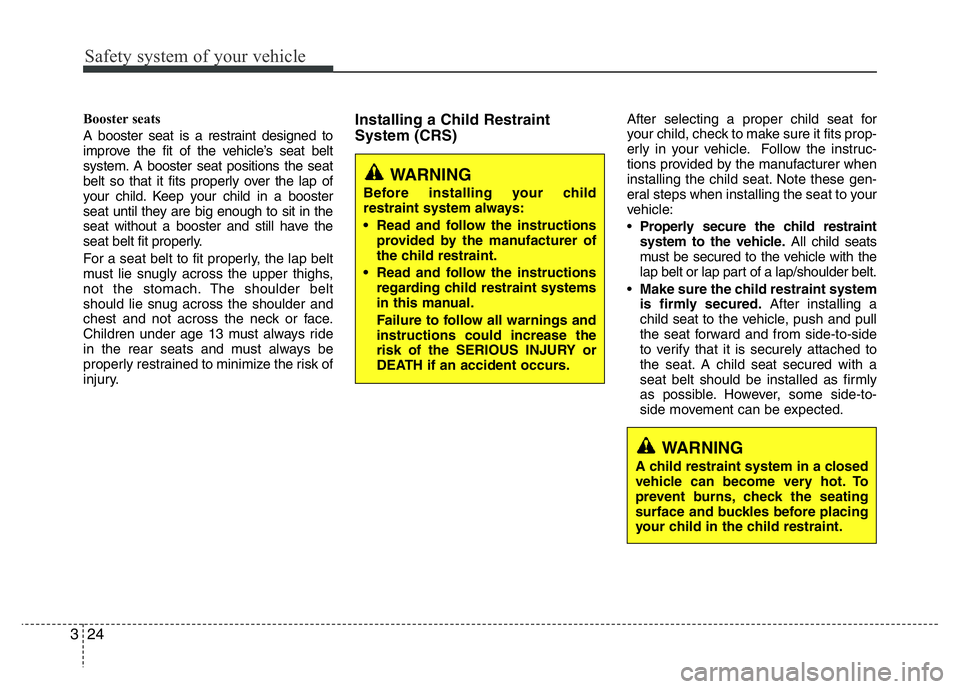
Safety system of your vehicle
24 3
Booster seats
A booster seat is a restraint designed to
improve the fit of the vehicle’s seat belt
system. A booster seat positions the seat
belt so that it fits properly over the lap of
your child. Keep your child in a booster
seat until they are big enough to sit in the
seat without a booster and still have the
seat belt fit properly.
For a seat belt to fit properly, the lap belt
must lie snugly across the upper thighs,
not the stomach. The shoulder belt
should lie snug across the shoulder and
chest and not across the neck or face.
Children under age 13 must always ride
in the rear seats and must always be
properly restrained to minimize the risk of
injury.Installing a Child Restraint
System (CRS) After selecting a proper child seat for
your child, check to make sure it fits prop-
erly in your vehicle. Follow the instruc-
tions provided by the manufacturer when
installing the child seat. Note these gen-
eral steps when installing the seat to your
vehicle:
•Properly secure the child restraint
system to the vehicle.All child seats
must be secured to the vehicle with the
lap belt or lap part of a lap/shoulder belt.
•Make sure the child restraint system
is firmly secured.After installing a
child seat to the vehicle, push and pull
the seat forward and from side-to-side
to verify that it is securely attached to
the seat. A child seatsecured with a
seat belt should be installed as firmly
as possible. However, some side-to-
side movement can be expected.
WARNING
Before installing your child
restraint system always:
• Read and follow the instructions
provided by the manufacturer of
the child restraint.
• Read and follow the instructions
regarding child restraint systems
in this manual.
Failure to follow all warnings and
instructions could increase the
risk of the SERIOUS INJURY or
DEATH if an accident occurs.
WARNING
A child restraint system in a closed
vehicle can become very hot. To
prevent burns, check the seating
surface and buckles before placing
your child in the child restraint.
Page 41 of 343
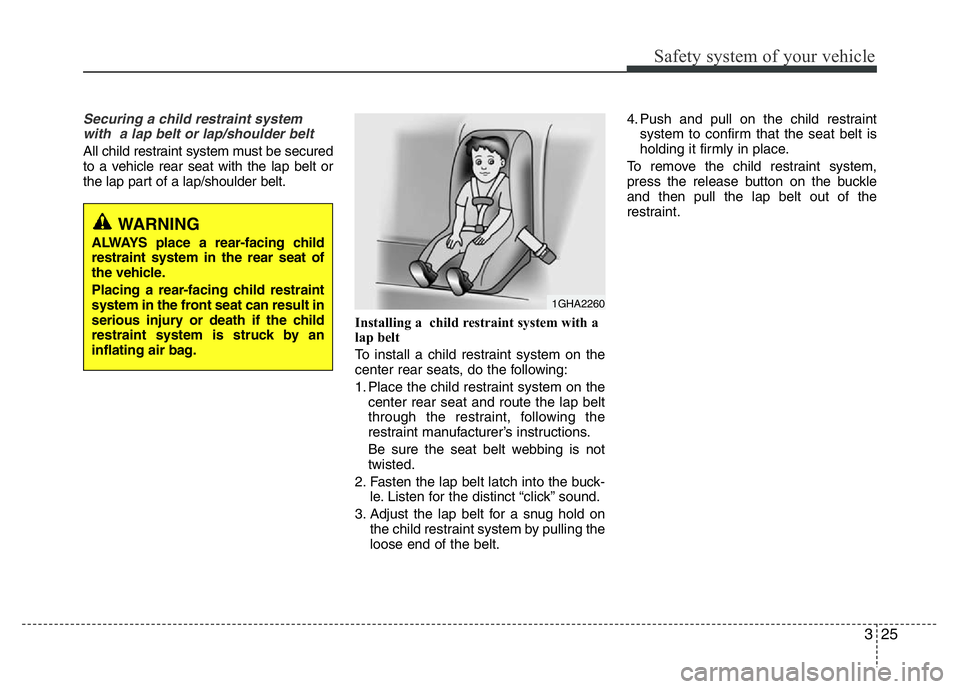
325
Safety system of your vehicle
Securing a child restraint system
with a lap belt or lap/shoulder belt
All child restraint system must be secured
to a vehicle rear seat with the lap belt or
the lap part of a lap/shoulder belt.
Installing a child restraint system with a
lap belt
To install a child restraint system on the
center rear seats, do the following:
1. Place the child restraint system on the
center rear seat and route the lap belt
through the restraint, following the
restraint manufacturer’s instructions.
Be sure the seat belt webbing is not
twisted.
2. Fasten the lap belt latch into the buck-
le. Listen for the distinct “click” sound.
3. Adjust the lap belt for a snug hold on
the child restraint system by pulling the
loose end of the belt.4. Push and pull on the child restraint
system to confirm that the seat belt is
holding it firmly in place.
To remove the child restraint system,
press the release button on the buckle
and then pull the lap belt out of the
restraint.
WARNING
ALWAYS place a rear-facing child
restraint system in the rear seat of
the vehicle.
Placing a rear-facing child restraint
system in the front seat can result in
serious injury or death if the child
restraint system is struck by an
inflating air bag.
1GHA2260
Page 43 of 343
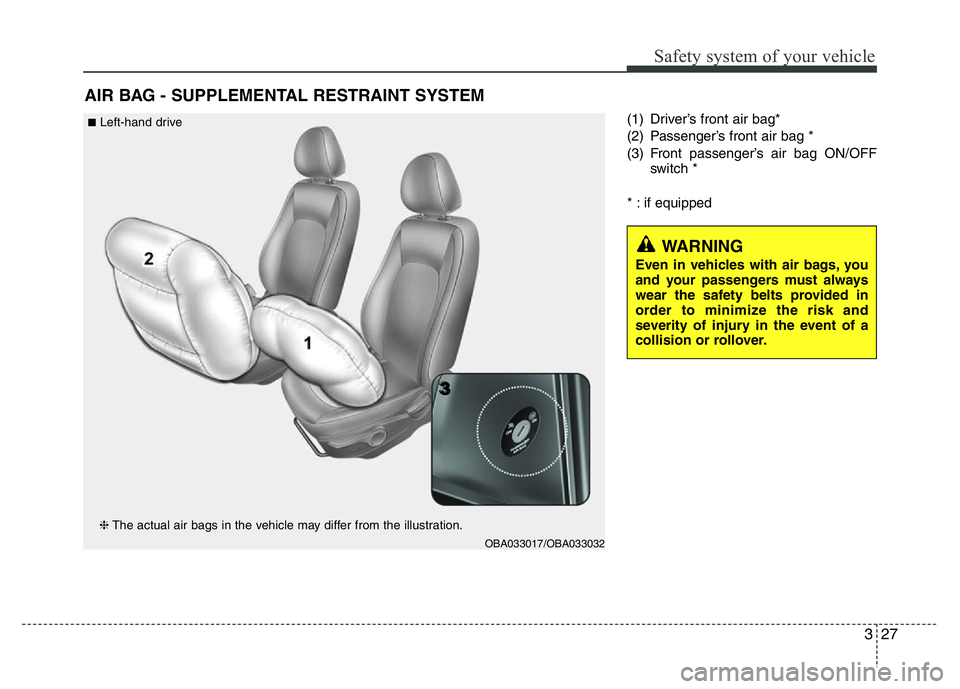
327
Safety system of your vehicle
(1) Driver’s front air bag*
(2) Passenger’s front air bag *
(3) Front passenger’s air bag ON/OFF
switch *
* : if equipped
AIR BAG - SUPPLEMENTAL RESTRAINT SYSTEM
WARNING
Even in vehicles with air bags, you
and your passengers must always
wear the safety belts provided in
order to minimize the risk and
severity of injury in the event of a
collision or rollover.
OBA033017/OBA033032
❈The actual air bags in the vehicle may differ from the illustration.
■Left-hand drive
3 3
Page 44 of 343
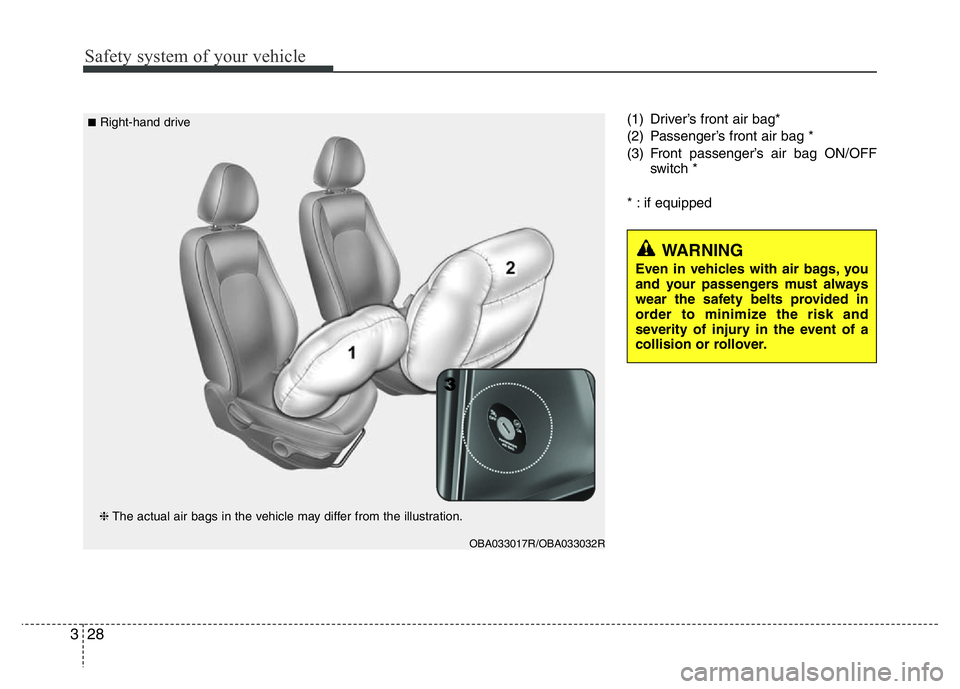
Safety system of your vehicle
28 3
(1) Driver’s front air bag*
(2) Passenger’s front air bag *
(3) Front passenger’s air bag ON/OFF
switch *
* : if equipped
WARNING
Even in vehicles with air bags, you
and your passengers must always
wear the safety belts provided in
order to minimize the risk and
severity of injury in the event of a
collision or rollover.
❈The actual air bags in the vehicle may differ from the illustration.
■Right-hand drive
OBA033017R/OBA033032R
3 3
Page 45 of 343
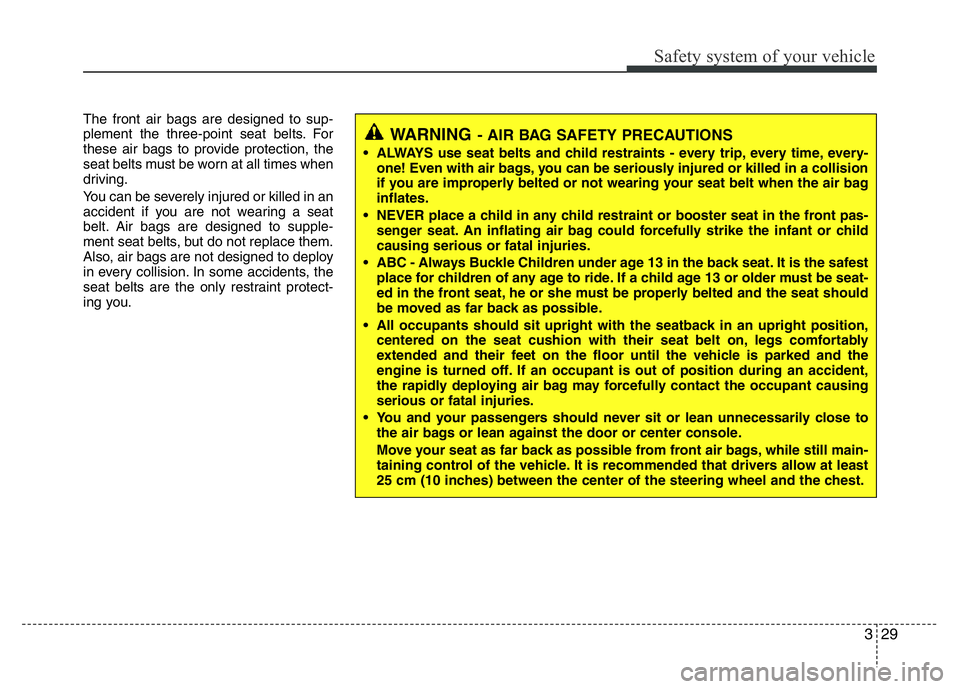
329
Safety system of your vehicle
The front air bags are designed to sup-
plement the three-point seat belts. For
these air bags to provide protection, the
seat belts must be worn at all times when
driving.
You can be severely injured or killed in an
accident if you are not wearing a seat
belt. Air bags are designed to supple-
ment seat belts, but do not replace them.
Also, air bags are not designed to deploy
in every collision. In some accidents, the
seat belts are the only restraint protect-
ing you.
WARNING- AIR BAG SAFETY PRECAUTIONS
• ALWAYS use seat belts and child restraints - every trip, every time, every-
one! Even with air bags, you can be seriously injured or killed in a collision
if you are improperly belted or not wearing your seat belt when the air bag
inflates.
• NEVER place a child in any child restraint or booster seat in the front pas-
senger seat. An inflating air bag could forcefully strike the infant or child
causing serious or fatal injuries.
• ABC - Always Buckle Children under age 13 in the back seat. It is the safest
place for children of any age to ride. If a child age 13 or older must be seat-
ed in the front seat, he or she must be properly belted and the seat should
be moved as far back as possible.
• All occupants should sit upright with the seatback in an upright position,
centered on the seat cushion with their seat belt on, legs comfortably
extended and their feet on the floor until the vehicle is parked and the
engine is turned off. If an occupant is out of position during an accident,
the rapidly deploying air bag may forcefully contact the occupant causing
serious or fatal injuries.
• You and your passengers should never sit or lean unnecessarily close to
the air bags or lean against the door or center console.
Move your seat as far back as possible from front air bags, while still main-
taining control of the vehicle. It is recommended that drivers allow at least
25 cm (10 inches) between the center of the steering wheel and the chest.
Page 46 of 343
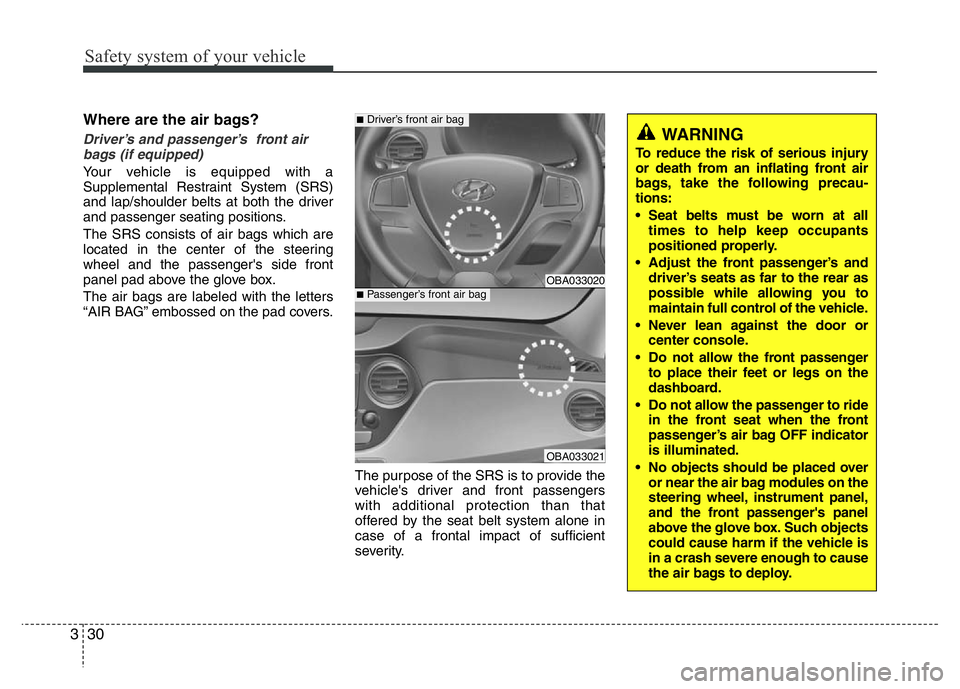
Safety system of your vehicle
30 3
Where are the air bags?
Driver’s and passenger’s front air
bags (if equipped)
Your vehicle is equipped with a
Supplemental Restraint System (SRS)
and lap/shoulder belts at both the driver
and passenger seating positions.
The SRS consists of air bags which are
located in the center of the steering
wheel and the passenger's side front
panel pad above the glove box.
The air bags are labeled with the letters
“AIR BAG” embossed on the pad covers.
The purpose of the SRS is to provide the
vehicle's driver and front passengers
with additional protection than that
offered by the seat belt system alone in
case of a frontal impact of sufficient
severity.
WARNING
To reduce the risk of serious injury
or death from an inflating front air
bags, take the following precau-
tions:
• Seat belts must be worn at all
times to help keep occupants
positioned properly.
• Adjust the front passenger’s and
driver’s seats as far to the rear as
possible while allowing you to
maintain full control of the vehicle.
• Never lean against the door or
center console.
• Do not allow the front passenger
to place their feet or legs on the
dashboard.
• Do not allow the passenger to ride
in the front seat when the front
passenger’s air bag OFF indicator
is illuminated.
• No objects should be placed over
or near the air bag modules on the
steering wheel, instrument panel,
and the front passenger's panel
above the glove box. Such objects
could cause harm if the vehicle is
in a crash severe enough to cause
the air bags to deploy.
OBA033020
OBA033021
■Driver’s front air bag
■Passenger’s front air bag
Page 47 of 343
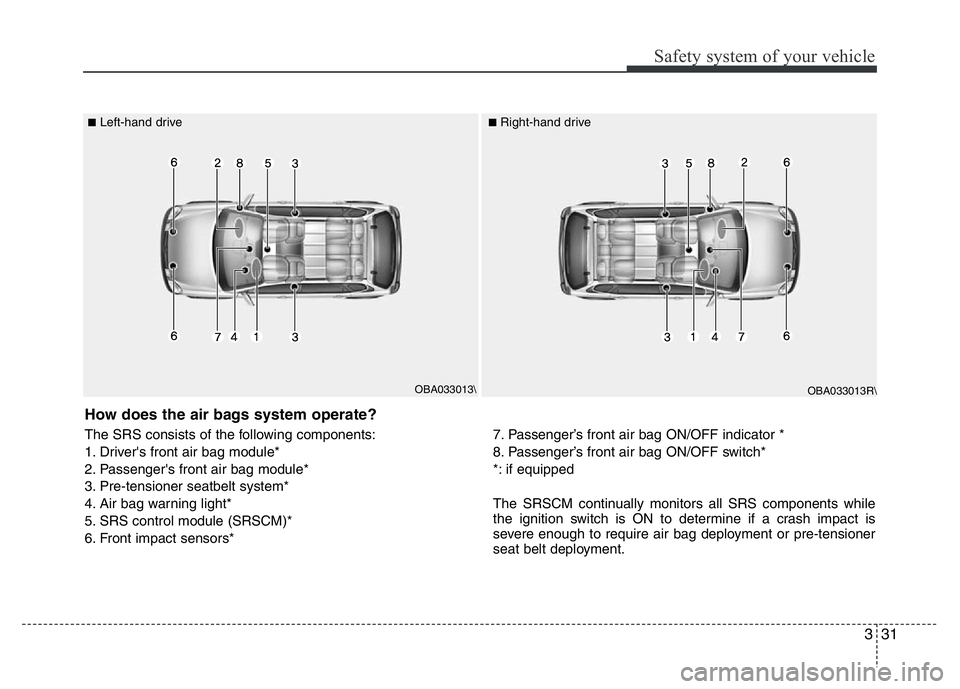
331
Safety system of your vehicle
OBA033013R\ OBA033013\ ■
Left-hand drive■Right-hand drive
How does the air bags system operate?
The SRS consists of the following components:
1. Driver's front air bag module*
2. Passenger's front air bag module*
3. Pre-tensioner seatbelt system*
4. Air bag warning light*
5. SRS control module (SRSCM)*
6. Front impact sensors*7. Passenger’s front air bag ON/OFF indicator *
8. Passenger’s front air bag ON/OFF switch*
*: if equipped
The SRSCM continually monitors all SRS components while
the ignition switch is ON to determine if a crash impact is
severe enough to require air bag deployment or pre-tensioner
seat belt deployment.
Page 48 of 343
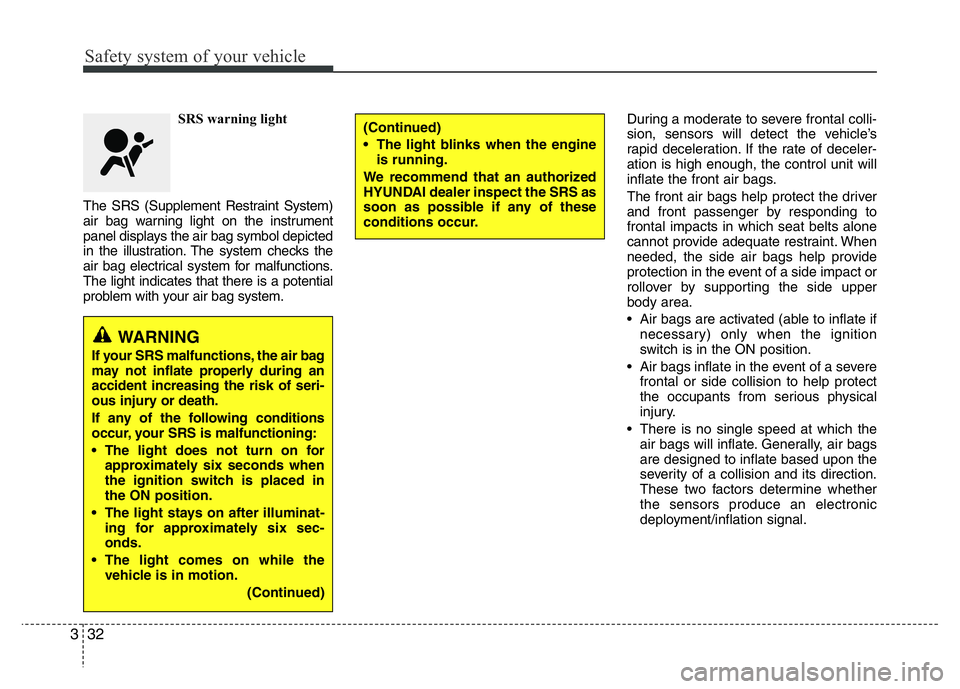
Safety system of your vehicle
32 3
SRS warning light
The SRS (Supplement Restraint System)
air bag warning light on the instrument
panel displays the air bag symbol depicted
in the illustration. The system checks the
air bag electrical system for malfunctions.
The light indicates that there is a potential
problem with your air bag system.During a moderate to severe frontal colli-
sion, sensors will detect the vehicle’s
rapid deceleration. If the rate of deceler-
ation is high enough, the control unit will
inflate the front air bags.
The front air bags help protect the driver
and front passenger by responding to
frontal impacts in which seat belts alone
cannot provide adequate restraint. When
needed, the side air bags help provide
protection in the event of a side impact or
rollover by supporting the side upper
body area.
• Air bags are activated (able to inflate if
necessary) only when the ignition
switch is in the ON position.
• Air bags inflate in the event of a severe
frontal or side collision to help protect
the occupants from serious physical
injury.
• There is no single speed at which the
air bags will inflate. Generally, air bags
are designed to inflate based upon the
severity of a collision and its direction.
These two factors determine whether
the sensors produce an electronic
deployment/inflation signal.
WARNING
If your SRS malfunctions, the air bag
may not inflate properly during an
accident increasing the risk of seri-
ous injury or death.
If any of the following conditions
occur, your SRS is malfunctioning:
• The light does not turn on for
approximately six seconds when
the ignition switch is placed in
the ON position.
• The light stays on after illuminat-
ing for approximately six sec-
onds.
• The light comes on while the
vehicle is in motion.
(Continued)
(Continued)
• The light blinks when the engine
is running.
We recommend that an authorized
HYUNDAI dealer inspect the SRS as
soon as possible if any of these
conditions occur.
Page 50 of 343
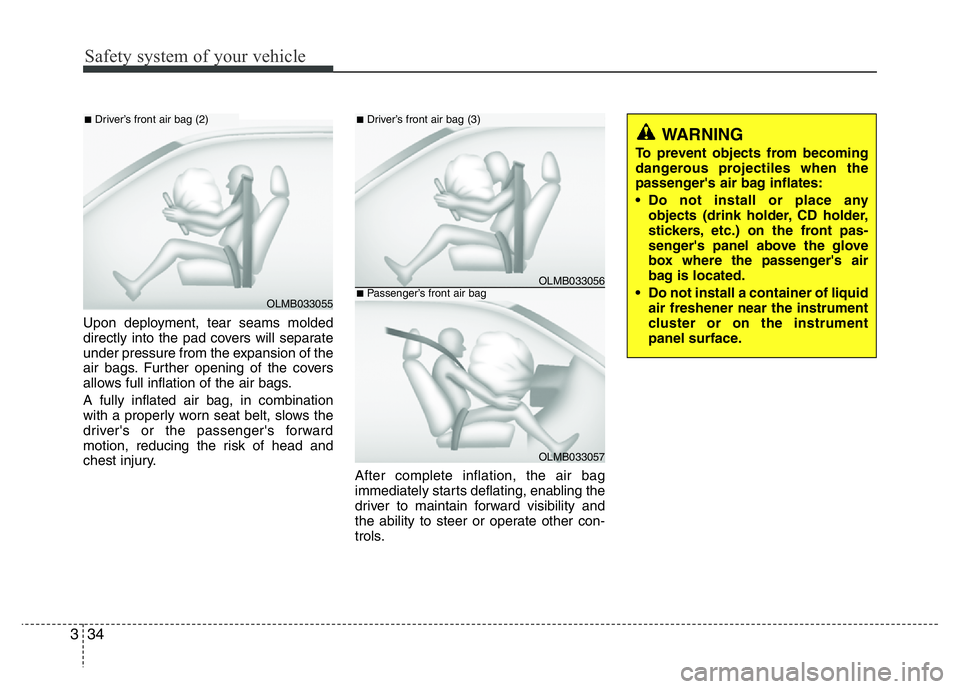
Safety system of your vehicle
34 3
Upon deployment, tear seams molded
directly into the pad covers will separate
under pressure from the expansion of the
air bags. Further opening of the covers
allows full inflation of the air bags.
A fully inflated air bag, in combination
with a properly worn seat belt, slows the
driver's or the passenger's forward
motion, reducing the risk of head and
chest injury.
After complete inflation, the air bag
immediately starts deflating, enabling the
driver to maintain forward visibility and
the ability to steer or operate other con-
trols.
OLMB033055
■Driver’s front air bag (2)
OLMB033056
■Driver’s front air bag (3)
OLMB033057
■Passenger’s front air bag
WARNING
To prevent objects from becoming
dangerous projectiles when the
passenger's air bag inflates:
• Do not install or place any
objects (drink holder, CD holder,
stickers, etc.) on the front pas-
senger's panel above the glove
box where the passenger's air
bag is located.
• Do not install a container of liquid
air freshener near the instrument
cluster or on the instrument
panel surface.